The State of Corruption in Latin America

Table of Contents
Author(s)
Paul Lagunes
Board of Advisors Visiting FellowShare this Publication
- Download PDF
- Print This Publication
- Cite This Publication Copy Citation
Lagunes, Paul, Xiaoxuan Yang, and Andrés Castro. 2019. The State of Corruption in Latin America. Baker Institute Report no. 07.08.19. Rice University’s Baker Institute for Public Policy, Houston, Texas.
“In the past few years, 11 presidents and former presidents in Latin America have been
forced from office, jailed, or are under investigation for corruption.”
—Congressional Research Service Report prepared for the U.S. Congress
The state of affairs in Latin America gives observers cause for concern due to the pervasive influence of corruption.1 Firms influence regulatory agencies and persevere in erecting buildings that violate the law (Barstow 2012; Barstow and Xanic von Bertrab 2012). Officials rig government procurement procedures and steal funds meant for the construction of public infrastructure (Di Tella and Schargrodsky 2003). Transit police unfairly target the poor with requests for bribes (Fried, Lagunes, and Venkataramani 2010). From the public graveyard to the office of the president, in a number of Latin American countries, there is scarcely an area of government that is beyond corruption’s reach (Hunt 2006; Grajales, Lagunes, and Nazal 2018).
The gravity of this issue is reflected in the high-profile scandals embattling the region, and also in the available data. With regard to the latter, in this report, we analyze survey-based measures of corruption made available by Transparency International (2018) and the Latin American Public Opinion Project (AmericasBarometer 2016). Among our findings, we confirm that Latin America’s average level of perceived corruption is relatively high. We also note that Latin America as a whole is not showing improvements in this area. This is concerning for a number of reasons, including the widely held suspicion that corruption has a negative impact on the economy. Our analysis reveals that higher rates of perceived corruption are associated with lower levels of economic welfare and direct foreign investment in the region. We conclude this report with suggestions for how government integrity can be improved.
Corruption Then & Now
Corruption stubbornly thrives in Latin America, a fact that is confirmed by Transparency International’s Corruption Perception Index (CPI). First established in 1995, the index attempts to measure public sector corruption and is calculated using surveys aimed at country experts and business leaders.2 A CPI score of 100 represents high levels of perceived integrity in government, while 0 stands for the opposite. Building on these data, Figure 1 shows a series of 21 boxplots. The boxplots in green represent the 20 countries with the lowest CPI scores, while the blue boxplots represent the 20 countries with the highest CPI scores. The remaining boxplots (i.e., those in orange) represent 18 Latin American countries.3 A key takeaway from this figure is that Latin America’s average level of government integrity was considerably lower than that of the countries with the most honest governments between 2012 and 2018. This is to say that Latin American countries are among the most burdened by corruption in the world (Morris and Blake 2009, 2). Another key insight from Figure 1 is that, during the time period of interest, the region made no perceived progress in the control of corruption.
Figure 1 — Levels of Perceived Corruption
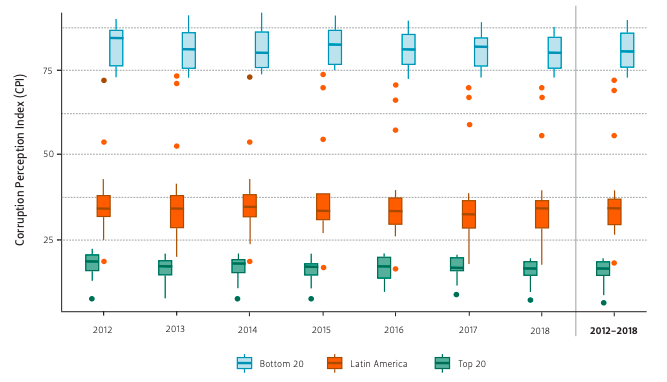
Source Transparency International.
Regional Outliers
Despite the perceived corruption levels shown in Figure 1, the relatively strong performance of a few Latin American countries leaves room for optimism. According to Figure 2, Uruguay, Chile, and Costa Rica enjoy relatively high levels of government integrity. This was not always the case. For instance, Uruguay used to rely on a clientelistic system of public sector appointments, and most government positions were allotted by political parties in exchange for electoral support (Buquet Corleto and Piñeiro 2017, 57, 60–63). However, in 1971, an outsider party whose support was not based on patronage (the Frente Amplio) managed to carve a place for itself in the political scene (Buquet Corleto and Piñeiro 2017, 65). This disturbed the duopolistic party structure and was one of the factors that made it possible to curb clientelism (Buquet Corleto and Piñeiro 2017, 66–70). As the case of Uruguay demonstrates, even if historical trends are hard to shake off, they may be surpassed—and that is precisely the path that Costa Rica appears to be on.
Figure 2 — Perceived Corruption Across Latin American Countries (2012–2018)
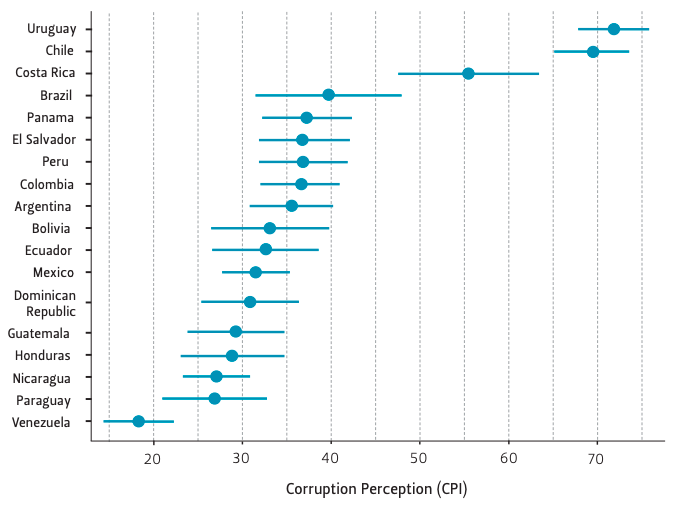
Source Transparency International.
During the colonial and most of the post-independence periods, officials in Costa Rica were expected to buy their positions in government, which encouraged bribe-seeking amongst officeholders (Wilson and Villarreal 2017, 189-90). Patronage and other forms of abuse were reportedly also common; however, Costa Rica began improving its governance framework around the turn of the twentieth century. Now, decades later, Costa Rica stands out from its Central American neighbors as a result of strengthening the system of checks and balances (Wilson and Villarreal 2017, 189-90). Few citizens experience corruption in their daily lives, and the country is at a stage where corruption scandals are infrequent and dealt with properly when they do occur (Wilson and Villarreal 2017, 205–207).
Chile is the third case meriting closer examination. The country’s history includes periods of intense corruption. Between 1891 and 1924, business elites actively sought close relations with politicians and bureaucrats in order to capture a greater share of rents (Montinola n.d.; Pollack and Matear 1997). Bribery was relatively common (Valenzuela 1977, 195), and political loyalty was achieved through patronage (Brinegar 2009, 133). However, conditions appear to have improved in 1927 with the creation of the Office of the Controller General, although the agency lost its independence during the period of authoritarian rule under Augusto Pinochet from 1973–1990 (Pollack and Matear 1997, 375; Brinegar 2009, 133).
During Pinochet’s dictatorship, power was concentrated in the executive branch, and even the Office of the Comptroller General was brought to heel (Pollack and Matear 1997, 376; Navia, Mungiu-Pippidi, and Martini 2017, 219). It is under these conditions that Pinochet arbitrarily used his power and amassed unexplained wealth (Skidmore and Smith 2001, 133; Rohter 2006; Levi, Dakolias, and Greenberg 2007, 398). During the dictatorship, members of the armed forces also enjoyed privileges not afforded to the general population (Pollack and Matear 1997, 376).
After democracy was restored in 1990, Chile made important strides in controlling corruption (Navia, MungiuPippidi, and Martini 2017, 222), though it is important to note that modern-day Chile is not trouble-free (Balán 2011, 471). As Table 1 shows, the country has regularly faced scandals since the 1990s.4 Nevertheless, that same table illustrates how these scandals are less frequent than in neighboring Argentina. All things considered, the level of corruption in Chile has been considerably lower than the level of corruption found in Mexico, Peru, or Brazil since the mid-1990s (Pollack and Matear 1997, 371).
Table 1 — Presidential Corruption Scandals
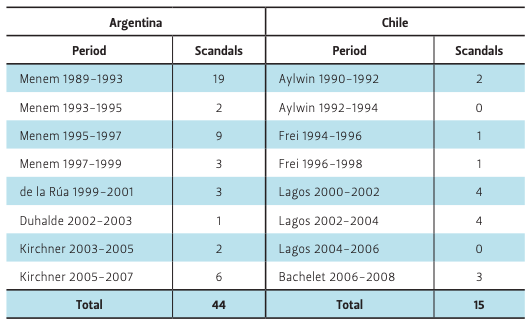
Source Table replicates data published by Balán (2011).
Beyond the Outliers
Looking beyond any single country, it is worth noting that corruption stands as one of the top five concerns for the region at large (see Figure 3). People prioritize corruption alongside public safety and economic issues. In fact, between 2008 and 2016, anxiety about corruption grew annually until approximately eight percent of those surveyed cited it as their country’s most significant problem. Media coverage of the various corruption scandals may explain some of this trend,5 though citizens’ direct experiences with corruption are likely also to blame.
Figure 3 — Corruption as a Major Public Concern (2008–2016)
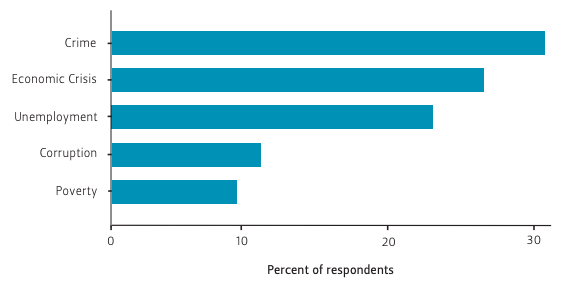
Source AmericasBarometer (2016).
Data obtained from the Latin American Public Opinion Project offers a glimpse into people’s experiences with corruption (AmericasBarometer 2016). The practice of bribery is especially pronounced in Bolivia, Mexico, Peru, and Paraguay. However, bribery continues to be practiced, even in countries with the strongest systems of accountability. Thus, it is fair to suggest that all jurisdictions, without exception, should redouble their effort to control corruption.
Corruption vs. the Economy
Perhaps surprisingly, not all are willing or able to recognize corruption’s damaging consequences. The case of China is sometimes brought up as evidence that economic growth is compatible with relatively high levels of corruption (e.g., Huang 2018). However, this viewpoint fails to consider that China’s growth could have been even greater were it not so burdened by corruption (Fisman 2010). The mainstream thinking on the question of whether corruption serves as “grease” or “sand” in the wheels of an economy is that countries around the world would fare better if their governments were more honest (Schleifer and Vishny 1993; Mauro 1995; Kaufmann 1997; Mo 2001; Aidt 2009).
A 2016 report by the International Monetary Fund (IMF) provides a useful summary of the relevant literature linking corruption to negative economic outcomes. Among the various issues highlighted, the report claims that corruption undermines government spending programs; contributes to generating large fiscal deficits and considerable debt accumulation; weakens financial oversight; and limits countries’ access to international credit markets (IMF Staff 2016, 6–15). Our own analysis suggests that corruption may have a negative impact on key economic indicators, such as gross domestic product (GDP) per capita and foreign direct investment (FDI).6 With regard to the former, Figure 4 shows that higher levels of corruption are associated with a lower standard of living. With regard to the latter, Figure 5 indicates that higher levels of corruption correlate with lower levels of FDI. Taken together, there is evidence to suggest that countries in Latin America would be better off if they managed to control corruption.
Figure 4 — CPI vs. GDP in Latin America
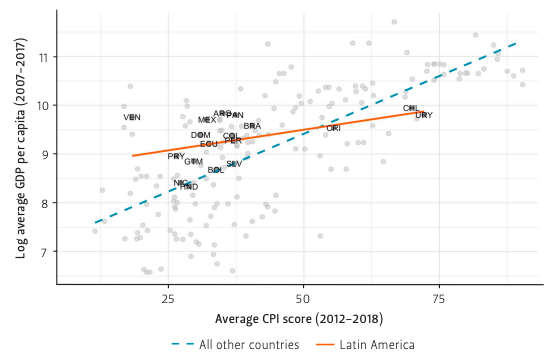
Source Transparency International and the World Bank.
Figure 5 — CPI vs. FDI in Latin America
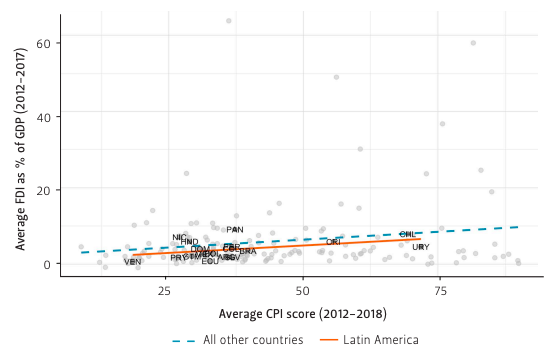
Sources Transparency International and the World Bank.
Some Suggestions for Corruption Control
By way of concluding this brief, we want to point to a few possible solutions to the corruption problem. One such solution involves promoting government transparency (e.g., Reinikka and Svensson 2005; Islam 2006; Cordis and Warren 2014). The underpinning assumption is that officials who work in transparent governments realize that their actions are subject to concurrent or after-the-fact review. Thus, they have little choice but to act with greater discipline and honesty.
Freeing information about government, however, is unlikely to be enough to ensure improved accountability. Indeed, increasing the probability of detection is far from being the only way to combat corruption. There are other factors that must come into play. In this sense, we agree with the authors of a recent Inter-American Development Bank report who argue that corruption control requires a multi-layered approach (Engel et al. 2018). The report delineates a series of initiatives that governments in Latin America should adopt, including identifying the beneficial owners of shell companies, eliminating barriers to extradition and mutual legal assistance, strengthening the enforcement of criminal laws, promoting citizen participation, and adopting new technologies. This last initiative in particular has received considerable attention in academic and policy circles, perhaps because of the sense that technology has the power to disrupt prevailing patterns and vested interests (e.g., Bussell 2012; Santiso 2018; López-Iturriaga and Pastor Sanz 2018; Pérez Argüello and Ziff 2019).
Turning to other possible solutions, deregulation and the simplification of government transactions can serve as effective anti-corruption mechanisms, especially since they eliminate opportunities for corrupt officials to extract illegal rents (de Soto 1989; Roseth, Reyes, and Santiso 2018). Outsourcing some services to private firms and revising employment mechanisms are two additional anticorruption tactics (Rose-Ackerman 1999, 71, 84-87). Improving the selection process of bureaucrats by emphasizing incorruptibility and technical competence is another way to reduce the risk that officials will misbehave (Calvert, McCubbins, and Weingast 1989, 599, 604-5).7 Experimental work also confirms that higher wages and bonus programs can have positive effects on public-sector hiring (Dal Bó, Finan, and Rossi 2013) and basic government functions (Khan, Khwaja, and Olken 2016).
Another way for governments to limit the probability that their staff will engage in corruption is by encouraging whistleblowers. This can be achieved by granting protection and incentives to insiders who report wrongdoing (Rose-Ackerman, 1999, 53, 58; Rose-Ackerman and Palifka 2016, 219-20; Mesmer-Magnus and Viswesvaran 2005). Yet another anticorruption strategy involves the judicious administration of officials’ duties. Reducing the number of agents in sensitive positions is a means of concentrating responsibility and facilitating supervision (Gardiner and Lyman 1978, 187; Schleifer and Vishny 1993). Sometimes, however, it is best to take the opposite approach by dissipating responsibility and generating intra-agency competition. The likelihood of corruption can be significantly reduced when officials lose monopoly power over the provision of certain goods, such as government permits (Rose-Ackerman 1978, 137-38).
Oversight mechanisms paired with a credible system of punishment are other important tools at reformers’ disposal. Indeed, there are grounds to believe that under certain conditions, independent audits can have a disciplinary effect on bureaucrats (Olken 2007; Lagunes 2017; Avis, Ferraz, and Finan 2018). Thus, following the argument presented in Lagunes’s book project, communities across Latin America should apply the eye and whip approach to corruption control (Lagunes n.d.). First, the eye: the members of civil society and, in a more immediate sense, the authorities charged with controlling corruption must be able to access and audit information about the inner workings of government. Second, in reference to the swift, targeted, and just approach to law enforcement, is the whip: high-level appointed officials and the authorities responsible for investigating and prosecuting corruption must offer a credible threat that penalties will be applied wherever wrongdoing is proven. Together, the eye and the whip can improve the behavior of government officials.
In closing, Latin American countries would do well to adopt a variety of anticorruption measures. Their citizens expect and deserve greater accountability.
Endnotes
1. Some of the material in this issue brief is drawn from Lagunes (2018).
2. Bukovansky (2015) warns that perception-based measures obscure differences between types of corruption and might even reinforce a country’s position of relative corruption. Still, when used appropriately, such indicators serve an important function. Mainly, they provide a general sense of the corruption problem in a given jurisdiction.
3. The analysis was limited to the 18 countries in Latin America for which there are corruption-related data in the Corruption Perception Index and the Latin American Public Opinion Project. The specific countries are: Argentina, Bolivia, Brazil, Chile, Colombia, Costa Rica, Dominican Republic, Ecuador, El Salvador, Guatemala, Honduras, Mexico, Nicaragua, Panama, Paraguay, Peru, Uruguay, and Venezuela.
4. Over the years, corruption scandals in Chile have touched a variety of sectors. During the 1990s, important public enterprises, such as a sewage plant in Valparaiso, and public agencies including the National Emergency Office in the Ministry of Interior, generated corruption complaints (Rehren 2004). Then, as the 1997 congressional election neared, an investigation revealed efforts by regional public enterprises, private contractors, regional and local authorities, and legislators to funnel public funds to campaigns (Rehren 2004). An assessment from the early 2000s also suggests that Chilean citizens were concerned about the lack of transparency in campaign financing (Rehren 2009, 55).
5. For a review of some of the recent scandals that afflicted Chile, Guatemala, Honduras, and Panama, see: Kevin Casas-Zamora and Miguel Carter, Beyond the Scandals: The Changing Context of Corruption in Latin America (Washington, D.C.: The Inter-American Dialogue, 2017).
6. These indicators are available for over 217 countries and are published by the World Bank (2019).
7. Civil service reform also involves setting up mechanisms to avoid conflicts of interest and to require that officials disclose their assets in a routine manner (Rose-Ackerman 1999, 74–76).
References
Aidt, Toke S. 2009. “Corruption, Institutions, and Economic Development.” Oxford Review of Economic Policy 25, no. 2: 27191.
AmericasBarometer. 2016. “Data Sets.” Nashville, TN: Latin American Public Opinion Project (LAPOP).
Avis, Eric, Claudio Ferraz, and Frederico Finan. 2018. “Do Government Audits Reduce Corruption? Estimating the Impacts of Exposing Corrupt Politicians.” Journal of Political Economy 126, no. 5: 1912–64.
Balán, Manuel. 2011. “Competition by Denunciation: The Political Dynamics of Corruption Scandals in Argentina and Chile.” Comparative Politics 43, no. 4: 459–78.
Barstow, David. 2012. “Wal-Mart Hushed up a Vast Mexican Bribery Case.” New York Times, April 21, 2012. https://www.nytimes.com/2012/04/22/business/at-wal-mart-in-mexico-a-bribe-inquiry-silenced.html.
Barstow, David, and Alejandra Xanic von Bertrab. 2012. “How Wal-Mart Used Payoffs to Get Its Way in Mexico.” New York Times, December 17, 2012. https://www.nytimes.com/2012/12/18/business/walmart-bribes-teotihuacan.html.
Beittel, June S., Peter J. Meyer, Clare Ribando Seelke, Maureen Taft-Morales, and Edward Y. Garcia. 2019. Combating Corruption in Latin America: Congressional Considerations. Washington, D.C.: Congressional Research Service.
Brinegar, Adam. 2009. “Evaluating Citizen Attitudes About Corruption in Chile.” In Corruption & Democracy in Latin America, edited by Charles H. Blake and Stephen D. Morris, 131–49. Pittsburgh, PA: University of Pittsburgh Press.
Bukovansky, Mlada. 2015. “Corruption Rankings: Constructing and Contesting the Global Anti-Corruption Agenda.” In Ranking the World: Grading States as a Tool of Global Governance, edited by Alexander Cooley and Jack Snyder, 60–84. Cambridge, UK: Cambridge University Press
Buquet Corleto, Daniel, and Rafael Piñeiro. 2017. “The Uruguayan Way from Particularism to Universalism.” In Transitions to Good Governance: Creating Virtuous Circles of Anticorruption, edited by Alina Mungiu-Pippidi and Michael Johnston, 57–101. Northampton, MA: Edward Elgar Publishing Limited.
Bussell, Jennifer. 2012. Corruption and Reform in India: Public Services in the Digital Age. New York: Cambridge University Press.
Calvert, Randall L., Mathew D. McCubbins, and Barry R. Weingast. 1989. “A Theory of Political Control and Agency Discretion.” American Journal of Political Science 33, no. 3: 588–611.
Cordis, Adriana, and Patrick Warren. 2014. “Sunshine as Disinfectant: The Effect of Freedom of Information Act Laws on Public Corruption.” Journal of Public Economics 115: 18–36.
Dal Bó, Ernesto, Frederico Finan, and Martín A. Rossi. 2013. “Strengthening State Capabilities: The Role of Financial Incentives in the Call to Public Service.” The Quarterly Journal of Economics 128, no. 3: 1169–218.
de Soto, Hernando. 1989. The Other Path. New York: Harper and Row.
Di Tella, Rafael, and Ernesto Schargrodsky. 2003. “The Role of Wages and Auditing During a Crackdown on Corruption in the City of Buenos Aires.” Journal of Law and Economics 46: 269–292.
Engel, Eduardo, Beth Simone Noveck, Delia Ferreira Rubio, Daniel Kaufmann, Armando Lara Yaffar, Jorge Londoño Saldarriaga, Mark Peith, and Susan Rose-Ackerman. 2018. Report of the Expert Advisory Group on Anti-Corruption, Transparency, and Integrity in Latin America and the Caribbean. Washington, D.C.: Inter-American Development Bank.
Fisman, Raymond. 2010. “The Bad Kind of Corruption.” Foreign Policy, March 24, 2010, https://foreignpolicy.com/2010/03/24/the-bad-kind-of-corruption/.
Fried, Brian, Paul Lagunes, and Atheendar Venkataramani. 2010. “Inequality and Corruption at the Crossroads: A Multi-Method Study of Bribery and Discrimination in Latin America.” Latin American Research Review 45, no. 1: 76-97.
Gardiner, John A., and Theodore R. Lyman. 1978. Decisions for Sale: Corruption and Reform in Land-Use and Building Regulation. New York: Praeger Publishers.
Grajales, Ana, Paul Lagunes, and Tomás Nazal. 2018. Anatomy of Urban Corruption: A Review of Official Corruption Complaints from a Mexican City. Houston, TX: Rice University’s Baker Institute for Public Policy.
Huang, Yukon. 2018. “China’s Economy Is Not Normal. It Doesn’t Have to Be.” New York Times, March 13, 2018, https://www.nytimes.com/2018/03/13/opinion/china-economy-corruption.html.
Hunt, Jennifer. 2006. “Why Are Some Public Officials More Corrupt Than Others?” In International Handbook on the Economics of Corruption, edited by Susan Rose-Ackerman, 323–47. Northampton, MA: Edward Elgar.
IMF Staff. 2016. Corruption: Costs and Mitigating Strategies. Washington, D.C.: International Monetary Fund.
Islam, Roumeen. 2006. “Does More Transparency Go Along with Better Governance?” Economics and Politics 18, no. 2: 121–167.
Kaufmann, Daniel. 1997. “Corruption: The Facts.” Foreign Policy 107 (Summer 1997): 114–131.
Khan, Adnan Q., Asim I. Khwaja, and Benjamin Olken. 2016. “Tax Farming Redux: Experimental Evidence on Performance Pay for Tax Collectors.” Quarterly Journal of Economics 131, no. 1: 219–71.
Lagunes, Paul. n.d. “The Eye & the Whip: Field Experiments on Corruption Control in the Americas.” Unpublished manuscript, Columbia University, School of International & Public Affairs.
———. 2017. “Guardians of Accountability: A Field Experiment on Corruption and Inefficiency in Local Public Works.” Working Paper. International Growth Centre.
———. 2018. A Report for the IDB on Corruption Control with a Focus on Latin America. Washington, D.C.: Inter-American Development Bank.
Levi, Michael, Maria Dakolias, and Theodore S. Greenberg. 2007. “Money Laundering and Corruption.” In The Many Faces of Corruption: Tracking Vulnerabilities at the Sector Level, edited by J. Edgardo Campos and Sanjay Pradhan, 389–426. Washington, D.C.: The World Bank.
López-Iturriaga, Félix, and Iván Pastor Sanz. 2018. “Predicting Public Corruption with Neural Networks: An Analysis of Spanish Provinces.” Social Indicators Research 140: 975–98.
Mauro, Paolo. 1995. “Corruption and Growth.” Quarterly of Journal of Economics 110: 681–712.
Mesmer-Magnus, Jessica R., and Chockalingam Viswesvaran. 2005. “Whistleblowing in Organizations: An Examination of Correlates of Whistleblowing Intentions, Actions, and Retaliation.” Journal of Business Ethics 62: 277–97.
Mo, Pak Hung. 2001. “Corruption and Economic Growth.” Journal of Comparative Economics 29, no. 1: 66-79.
Montinola, Gabriella R. n.d. “Political Competition, Rent-Seeking and Corruption: The Emergence of ‘Clean’ Government in Chile.” G-COE GLOPE II Working Paper Series, 31.
Morris, Stephen D., and Charles H. Blake. 2009. “Introduction: Political and Analytical Challenges of Corruption in Latin America.” In Corruption & Democracy in Latin America, edited by Charles H. Blake and Stephen D. Morris, 1–22. Pittsburgh, PA: University of Pittsburgh Press.
Navia, Patricio, Alina Mungiu-Pippidi, and Maira Martini. 2017. “Chile: Human Agency against the Odds.” In Transitions to Good Governance: Creating Virtuous Circles of Anti-Corruption, edited by Alina Mungiu-Pippidi and Michael Johnston, 213–233. Northampton, MA: Edward Elgar Publishing Limited.
Olken, Benjamin. “Monitoring Corruption Evidence from a Field Experiment in Indonesia.” Journal of Political Economy 115, no. 2 (2007): 200–249.
Pérez Argüello, María Fernanda, and Tamar Ziff. 2019. Hacking Corruption: Tech Tools to Fight Graft in the Americas. Washington, D.C.: Inter-American Dialogue and the Atlantic Council of the United States.
Pollack, Benny, and Ann Matear. 1997. “Dictatorship, Democracy and Corruption in Chile.” Crime, Law & Social Change 25: 371–82.
Rehren, Alfredo. 2004. “Politics and Corruption in Chile: The Underside of Chilean Democracy.” Harvard Review of Latin America (Spring): 14-15.
———. 2009. “The Crisis of the Democratic State.” In Corruption & Democracy in Latin America, edited by Charles H. Blake and Stephen D. Morris, 46-59. Pittsburgh, PA: University of Pittsburgh Press.
Reinikka, Ritva, and Jakob Svensson. 2005. “Fighting Corruption to Improve Schooling: Evidence from a Newspaper Campaign in Uganda.” Journal of the European Economic Association 3, no. 2: 259–67.
Rohter, Larry. 2006. “Colonel’s Death Gives Clues to Pinochet Arms Deals.” New York Times, June 19, 2006, https://www.nytimes.com/2006/06/19/world/americas/19chile.html?mtrref=www.google.com&gwh=3EE557E4A2118AC38765A61880514330&gwt=pay.
Rose-Ackerman, Susan. 1978. Corruption: A Study in Political Economy. New York: Academic Press.
———. 1999. Corruption and Government. New York: Cambridge University Press.
Rose-Ackerman, Susan, and Bonnie J. Palifka. 2016. Corruption and Government: Causes, Consequences, and Reform. 2nd ed. New York: Cambridge University Press.
Roseth, Benjamin, Angela Reyes, and Carlos Santiso. 2018. Wait No More: Citizens, Red Tape and Digital Government. Washington, D.C.: Inter-American Development Bank.
Santiso, Carlos. 2018. “Will Blockchain Disrupt Government Corruption?” Stanford Social Innovation Review.
March 5, 2018.
Schleifer, Andrei, and Robert W. Vishny. 1993. “Corruption.” The Quarterly Journal of Economics 108, no. 3: 599–617.
Skidmore, Thomas E., and Peter H. Smith. 2001. Modern Latin America. 5th ed. New York: Oxford University Press.
Transparency International. 2018. Corruption Perceptions Index 2018. Berlin, Germany: Transparency International, 2018.
Valenzuela, Arturo. 1977. Political Brokers in Chile: Local Government in a Centralized Polity. Durham, NC: Duke University Press.
Wilson, Bruce M., and Evelyn Villarreal. 2017. “Costa Rica: Tipping Points and an Incomplete Journey.” In Transitions to Good Governance: Creating Virtuous Circles of Anticorruption, edited by Alina Mungiu-Pippidi and Michael Johnston, 184-212. Northampton, MA: Edward Elgar Publishing Limited.
World Bank. 2019. “World Development Indicators.” Washington, D.C.: The World Bank.
This material may be quoted or reproduced without prior permission, provided appropriate credit is given to the author and Rice University’s Baker Institute for Public Policy. The views expressed herein are those of the individual author(s), and do not necessarily represent the views of Rice University’s Baker Institute for Public Policy.


